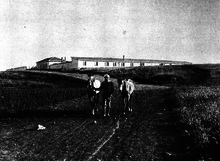Poria Illit
Poria Illit (Hebrew: פּוֹרִיָּה עִלִּית, lit. "Upper Poria") is a community settlement in northern Israel. Located near the southwestern shore of the Sea of Galilee,[2] it falls under the jurisdiction of Emek HaYarden Regional Council. In 2019 it had a population of 1,162.[1]
Poria Illit פּוֹרִיָּה עִלִּית | |
|---|---|
 Poria Illit  Poria Illit | |
| Coordinates: 32°44′11″N 35°32′37″E | |
| Country | |
| District | Northern |
| Council | Emek HaYarden |
| Founded | 1912 (original) 1940 (first re-establishment) 1955 (second re-establishment) |
| Population (2019)[1] | 1,162 |
| Name meaning | Upper Poria |
History

Poria was first settled in 1912 and operated as a farm run by Jewish immigrants from the Second Aliyah. However, the original residents left after the outbreak of World War I, and the land was abandoned until 1940.
That year a group of settlers (kvutza) affiliated with the socialist-Zionist Noar HaOved (Working Youth) movement, Alumot, settled in the area. They renovated the original basalt stone houses, naming the village Poria Alumot. In 1947 they were given a permanent site for their kibbutz at Bitania Illit, on a hill opposite Poria. The new kibbutz was named Alumot.
Another kibbutz founded in its place was dissolved in 1949 and most of the residents moved to Alumot. Poria Illit was established in 1955.[3] In 1991 it was officially recognized as distinct from Poria – Neve Oved.
According to the Company for Location and Restitution of Holocaust Victims’ Assets, there are 65 plots in Poria that were purchased by Jews who later died in the Holocaust.[4]
Health care
Poriya Medical Center was founded in 1955, replacing Schweitzer Hospital. The center incorporates a maternity hospital owned by the Scottish Church that was previously located in Tiberias. In 2005, the center was renamed for Prof. Baruch Padeh, former director-general of the Ministry of Health, who headed the hospital in 1974–1976. Located on Poriya Ridge above Tiberias, it serves the population of Tiberias, Golan Heights, Jordan Valley, Lower Galilee, kibbutzim and moshavim.[5]
References
- "Population in the Localities 2019" (XLS). Israel Central Bureau of Statistics. Retrieved 16 August 2020.
- Bringing the Boondocks in From Beyond the Pale Haaretz
- Poria Illit Galilee Development Authority (in Hebrew)
- A Gift From Shoah Victims to Survivors, Decades On Haaretz
- Poriya Medical Center